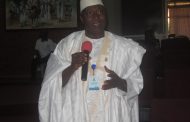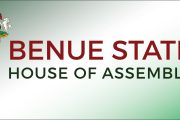It was, indeed, a new phase when many stalwarts of the long, National Association of Nigerian Students, (NANS) led struggle against military dictatorship started getting married around the late 1980s to the mid 1990s. That is the phase the above cover picture symbolises, 25 years after.

Amina Salihu and daughter @ a recent event
Salihu Lukman could be argued to have probably set the ball rolling by tying it with Amina Salihu. Theirs was the ABU, Zaria connection. It appeared that the former president of NANS had been eyeing Amina even in the course of the struggle.
Comrade Y Z Y’au did his in late 1995. He was the typical comrade getting married. It is difficult to forget the image of Attahiru Jega strolling into Y Z’s house at Bayero University in Kano and wondering aloud if that was where a new wife was arriving shortly. He took it upon himself to rework the space by pushing books and handbills and posters to where he though they belonged and giving primacy to the seats and so on. It may be said that Chima Ubani brought this to the climax, leaving three or so children before he continued the journey to the other side of the world.
Dr. Otive Igbuzor was not to be left out of the show. In his own case, a senior comrade has been quoted as saying that the way Otive was dancing at his own wedding, you could guess it wouldn’t be long before he did something ‘strange’ to Marxism. He turned out to be correct. Dr. Otive may be credited with the ‘Pastor turn’ in Nigerian Marxism.
John Odah was either following or reinforcing this trend when he did his own April 22nd, 1995 in Makurdi with Angela Ogodor Aba who was still a History undergraduate at UNICAL. It was, like all such marriages, very much part of the phase. According to Mr. Labaran Maku who was himself a one-time Public Relations Officer of the now dead NANS John Odah was part of the squad that led Nigerian students’ onslaught on military dictatorship throughout the eighties as well as the defence of the dignity of the African and the idea of standing up for democracy. John, according to Maku, is not someone who puts himself in the front but a key operator behind the massive action you see in the front. He was an activist whose sense of commitment could cut through any mountain, a real product of communal upbringing in the rural society and its high sense of value, propriety and culture. It can hardly be better put.
But the phase raises a question. Was it in the nature of things or what people call reality or is this obedience to society’s codes or is it maturity that young men and women who dared the military in power were getting married and settling down after all? And 15, 20, 25 years later, they are now fathers and even grandfathers, still radical but, to borrow society’s language for it, more mature. Many are even in government or running some enterprise and so on.

It was a substantially comradely affair, for those who can make out the faces though some are, unfortunately, late now
What a story for a generation about whom nobody was sure if they could kiss a girl. Is this also what happened to the nationalists who fought the colonialists: taking time off the ‘revolution’ to get married, settle down and become bothered by raising children, worrying about their progress and becoming ‘mature’ or ‘reasonable’?
The above background makes the above picture to mean more than just the picture of one Comrade John Odah and his beau but, more importantly, a generational statement refracting a moment in the metamorphosis of a definitive collectivity in postcolonial Nigeria. In other words, this picture freezes a moment in the life of a generation of Nigerians nationwide, united in the possibility of remaking of Nigeria at a time Nigerians were still hoping that the power elite which inherited authority from the colonialists would hopefully make good. Spread across the campuses, they organised into the Patriotic Youth Movement of Nigeria, (PYMN) and floated platforms that challenged absolutist practices of power that successive military dictators were manifesting especially through a belt tightening paradigm that started with withdrawing conditions of possibility for quality training in the universities.
This consciousness acquired organisational coherence in the aftermath of the first nationwide students’ resistance to the first steps in what later became the Structural Adjustment Program, (SAP). In other words, it concretised with the formation of the National Association of Nigerian Students, (NANS) in the early 1980s in the aftermath of the resistance led by the progenitor, the National Union of Nigerian Students, (NUNS). NUNS became NANS after “Ali Must Go” protests of 1978 which claimed the lives of several students and the punishment of qualitative Vice-Chancellors. NANS shook up the society, creating a protest consciousness with the help of the mass media, the cleric and middle class professionals such as the Nigerian Medical Association, (NMA); the National Association of Resident Doctors, (NARD); the Nigerian Bar Association, (NBA) and the labour movement, especially under the NLC presidency of Ali Chiroma.

It is open to debate if there can be a better epitaph than a slight editing of this rulebook into the language of the mysterious common man
An epitaph is yet to be written to a yet to be built monument to a wonderful and very successful movement but, by the early 1990s, the National Democratic Revolution that was being pursued had come under its own contradictions. The battering of the universities had started taking its toll on critical and imaginative understanding of the categories involved in the noble pursuit. Sacrifices that were made and the privileges they had secured on the campuses were being taken for granted by succeeding movement leaders over time. Repression through preemptive expulsion, prolonged detention and judicial terrorism were equally taking a toll. University academics who equated their position to that of Brigade-Commanders in the military began to emerge as Vice-Chancellors in large numbers, with ego that brooked no opposition from students. Campuses became diluted with multiple centres of power such as Scripture Unions, (SU) and Muslim Students Society, (MSS), some of them with agenda that coincided with those of the university authorities.
By 1994 when what Nigerians had come to know as NANS held an elective convention at the Obafemi Awolowo University, Ile-Ife, it was a shield of human chains that decided the outcome of the election, not any modicum of voting. The outcome was the take-over of NANS by a tendency that had been predicted and named as the ‘Sergeant Doe’ sort of leaders. As the late Chima Ubani put it in a memorable aftermath, “reaction had found its own strength in NANS politics”. But, the Women in Nigeria, (WIN), a sister platform of the NANS had an even more intriguingly violent end over an issue that was not an issue at all. It was not a different story in the Campaign for Democracy, (CD), the umbrella organisation that unified democratic forces across the country. It split right down the middle. Not even the Nigerian Labour Congress, (NLC) which had the benefit of a pool of forward looking band of critical scholars survived what was happening. What it tasted earlier in the form of a split in the late 1980s came back in the form of a child’s play as leadership itself began to be progressively problematic.
No definitive history of the crash has been written. That is if there is any history we can call definitive since every history is but a narrative. So, the question of whether it was imperialism or military dictatorship or internal rottenness within the radical construct or all three combining to crash out the radical tradition since the 1990s has no answer yet just as there has been not much progress in terms of regrouping. Whether the post COVID-19 scenario will force a radical renewal is the question!
Congratulations to Comrades John and Angela Odah!




























